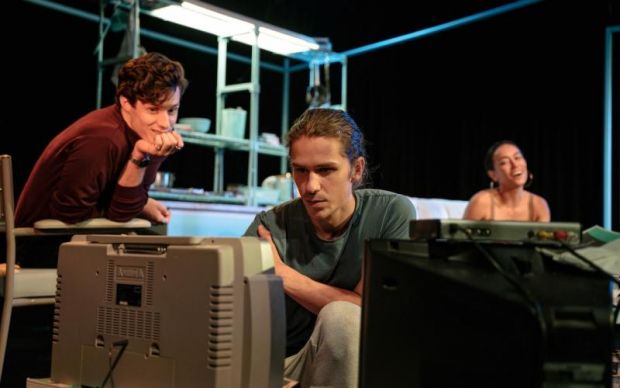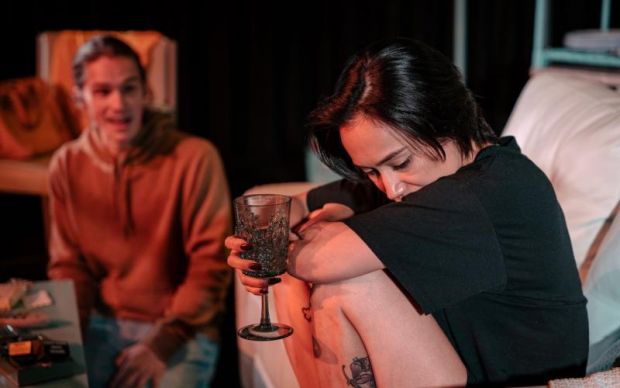Music
Music is a play about mental illness – or, more precisely, responses to mental illness by people who are supposedly not mentally ill. So, it is a play about listening, about seeing, and understanding. As the character Adam says in a fine speech towards the end of the play, music as communication came before words, and we have to find the music in the chaos of another human being. So, equally, it is a play about not listening, not seeing, and not understanding.
Adam (Ben Smalley) is a young man recovering from mental illness. He was in hospital for a long time – a very bad experience, as we learn. Now he lives alone in a small tower block flat; he’s on medication and checks in at ‘the Centre’ to see his case worker. He has a vast collection of music, which is his calming connection to the world. Adam is a tactfully and empathetically written character, mercurial, open, naïve, fearful, suspicious, literal minded, awkward, affectionate, absurdly optimistic about his future, his reasoning sometimes skewed, his sense of what’s ‘funny’ often surprising. Ben Smalley brings all of this together in a fine performance that makes a coherent, plausible character about whom we care – and fear for.

One day there’s a knock on his door. A young actor (or would-be actor), Gavin (William Schofield) is researching a mentally ill character for a play. We somehow know that Gavin is probably a not very good actor, and that he’s out of his depth. He’s seen Adam at the Centre and followed him home. The presumptuous intrusion is breathtaking, but lonely Adam – who is a ‘good person’ - warms to Gavin, despite asking, ‘The character you’re playing, is he like me?’ Then, more presumption: Gavin brings another actor from the play, Sarah (Marniesa Martinez) unannounced, around to meet Adam. It’s initially a painful scene, but potty-mouth party girl Sarah goes beyond ‘research’ and starts to see Adam the man. Tom (David Burnstock), Adam’s mate, a delegate from Adam’s Mum (I think), points up how fragile Adam’s sanity actually is; he’s rightly suspicious of Gavin and Sarah. But for Tom, Adam is a ‘problem’: his main concern is that diabetic Adam stays on his medication, stays off alcohol, and not go dangerously off the rails again. Fair enough – but no ‘music’ there.

The passage of time across the play’s six scenes is sometimes vague, but relationships develop believably - but in ways that only increase the tension. We wonder if Adam might be devastated by his relationship with Sarah. We see Gavin become childishly proprietorial – ‘He was my friend first.’ We wonder what might happen when Adam reads Gavin and Sarah’s play…
Director Zachary Dixon is also the designer and his stylized, open yet claustrophobic design for Adam’s flat is elegant, clever, and disturbing. As director, however, there are some glitches besides the passage of time. Towards the end, one character is badly injured and it’s not clear how. A case worker arrives at the door, but who called them? And what happens then? But a more central concern is the cast’s performance.
It is interesting that Music is supposed to run 90 minutes, but the performance I saw ran close to 105 minutes. Watching the play, I was increasingly and unfortunately aware of the text that of course underlies the performances. You hear the lines and sense that in the words on the page there may be more switches, more light and shade and more humour than you are seeing onstage.

A director’s note makes clear that Zachary Dixon is aware of how this play ‘jumps between comedy and drama from moment to moment’, but, leaving aside Ben Smalley’s consistently fine, nuanced performance, I was left wondering if the text might be better served by a less ‘earnest’, less actorly cast with less ‘significant’ pausing. Despite the stylized set, Dixon has gone for naturalism, meaning an excess of props that must be got on and got off, and real processes (cooking scrambled eggs or a stir fry) that must be managed. It’s been said that naturalism is the greatest construct of all – and here it slows momentum and may even obscure that ‘music’ in the chaos that Adam describes so allusively and beautifully.
Michael Brindley
Subscribe to our E-Newsletter, buy our latest print edition or find a Performing Arts book at Book Nook.

